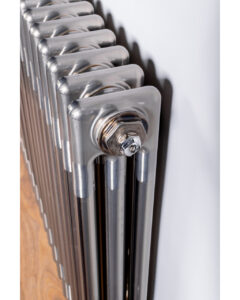Step-By-Step Guide: How to Remove a Radiator Safely
Removing a radiator may seem like a daunting task, but with the right steps and precautions, it can be done safely. In this step-by-step guide, we will walk you through the process of removing a radiator in your home.
Key Takeaways:
- Removing a radiator can be done safely with the right steps and precautions.
- Gather the necessary tools before starting the removal process.
- Turn off the heating system and drain the radiator before disconnecting it from the pipes.
- Be cautious of any remaining water and carefully remove the radiator from the wall brackets or supports.
- Seal the pipes to prevent leaks and ensure proper functioning of the heating system.
Tools for Removing a Radiator
Before you begin removing a radiator, it’s important to gather the necessary tools. Having the right tools on hand will make the process easier and help ensure a safe removal. Here are the essential tools you’ll need:
- Adjustable wrench
- Pliers
- Drain pan
- Radiator key
- Towel or rag
- Bucket
The adjustable wrench and pliers will be used to loosen and disconnect the radiator from the pipes. The drain pan and bucket will catch any dripping water during the removal process. The radiator key is necessary for opening the bleed valve to release pressure from the radiator. Lastly, the towel or rag can be used to catch any drips when loosening the nuts connecting the radiator to the pipes.
Having all of these tools handy will save you time and ensure that you have everything you need to safely remove a radiator from your home.
“Having the right tools for the job is essential when it comes to removing a radiator. These tools will make the process easier and help prevent any mishaps or damage.”
| Tool | Description |
|---|---|
| Adjustable wrench | A wrench with a movable jaw that can be adjusted to fit different sizes of nuts and bolts. |
| Pliers | A hand tool with two jaws used for gripping, twisting, or cutting objects. |
| Drain pan | A container used to catch any draining fluids, such as water or coolant. |
| Radiator key | A specialized key used to open the bleed valve on a radiator to release trapped air or pressure. |
| Towel or rag | A cloth used to soak up any liquid or protect surfaces during the removal process. |
| Bucket | A container with a handle used for various purposes, including catching water or storing tools. |
Turning Off the Heating System and Draining the Radiator
Before you begin the process of removing a radiator, it is essential to turn off the heating system to ensure your safety. Locate the radiator valves, which are usually located at the bottom of the radiator, and use an adjustable wrench to shut them off. This will prevent any hot water or steam from flowing through the radiator while you work. It is important to exercise caution when handling the valves to avoid any damage or leaks.
Next, prepare a drain pan or bucket underneath the radiator to catch any water that may drip out during the draining process. With the drain pan in place, use a radiator key to open the bleed valve. This valve is typically located at the top of the radiator. Opening the bleed valve will release the pressure inside the radiator, allowing the water to drain out.
Once you have opened the bleed valve, wait for the water to stop flowing. This process may take a few minutes, depending on the size of the radiator and the amount of water inside. Once the flow of water has ceased, close the bleed valve securely using the radiator key. This step ensures that no water will leak out once you disconnect the radiator from the pipes.
| Precautions for Draining a Radiator |
|---|
| Ensure the heating system is turned off to avoid accidents and burns. |
| Use an adjustable wrench to shut off the radiator valves securely. |
| Place a drain pan or bucket underneath the radiator to catch any water that may drip out. |
| Open the bleed valve using a radiator key to release the pressure and allow the water to drain. |
| Close the bleed valve securely once the water has stopped flowing. |
Disconnecting the Radiator from the Pipes
When it comes to DIY radiator removal, disconnecting the radiator from the pipes is a crucial step. This process requires caution and attention to ensure the safe disconnection of the radiator. Follow the steps below to disconnect your radiator from the pipes.
Gather the Necessary Tools
Before you begin disconnecting the radiator, make sure you have the right tools on hand. You will need an adjustable wrench or pliers to loosen the nuts connecting the radiator to the pipes. Additionally, have a towel or rag ready to catch any drips of water that may occur during the disconnection process.
Loosen the Nuts
Locate the nuts that secure the radiator to the pipes. Using your adjustable wrench or pliers, carefully loosen these nuts by turning them counter clockwise. Be cautious of any remaining water in the radiator and pipes to avoid any spillage or accidents. Place the towel or rag under the nuts to catch any drips.
Remove the Radiator
Once the nuts are loose, you can carefully remove the radiator from the wall brackets or supports. It’s important to handle the radiator with care, as they can be heavy and cumbersome. If possible, it’s best to have someone assist you in lifting and removing the radiator. Take your time and ensure the radiator is completely detached from the pipes before proceeding.
By following these steps, you can safely disconnect the radiator from the pipes during the DIY radiator removal process. Remember to take necessary precautions, be mindful of any remaining water, and seek assistance if needed.
| Tools Required | Steps |
|---|---|
| Adjustable wrench or pliers | Gather the necessary tools |
| Towel or rag | Gather the necessary tools |
| Loosen the nuts | Loosen the nuts with an adjustable wrench or pliers |
| Remove the radiator | Carefully detach the radiator from the wall brackets or supports |
Removing the Radiator Safely
Once the radiator is disconnected from the pipes, it’s time to safely remove it from the wall brackets or supports. It’s essential to handle the radiator with care, as they can be heavy and cumbersome. To ensure a smooth removal process, follow these step-by-step instructions:
- Enlist the help of another person to assist you in lifting the radiator off the brackets. This will prevent any strain or potential accidents.
- Ensure that the area where you plan to place the radiator is clear of any fragile objects or furniture. Radiators can cause damage if accidentally dropped or mishandled.
- Gently lift the radiator off the wall brackets, keeping it level to avoid any spills or leaks.
- Once the radiator is safely removed, place it in the designated location and proceed with caution to avoid any injuries or water damage.
Remember, safety should always be a top priority when removing a radiator. By following these steps, you can successfully remove the radiator without any accidents or damage.
Removing a radiator requires careful handling to ensure both personal safety and the protection of your property. Always have an extra pair of hands to help with lifting and be mindful of the weight and size of the radiator. Taking the necessary precautions will make the removal process much smoother and prevent any potential accidents.
Table: Radiator Removal Safety Tips
| Tips | Details |
|---|---|
| Enlist Assistance | Have another person assist you in lifting and removing the radiator to avoid strain or accidents. |
| Clear Surrounding Area | Ensure that the area where the radiator will be placed is clear of any fragile objects or furniture. |
| Lift Carefully | When removing the radiator from the brackets, lift it gently and keep it level to prevent spills or leaks. |
| Mindful Placement | Place the removed radiator in a safe location to avoid injuries or water damage. |
Sealing the Pipes
Once you have successfully removed the radiator from your home, it is important to take the necessary steps to seal the pipes properly. This will prevent any leaks and ensure the efficient functioning of your heating system. Sealing the pipes is a relatively straightforward process that can be done with the help of pipe caps or plugs.
Sealing the Pipes – Step by Step
- First, ensure that the open ends of the pipes are clean and dry.
- Next, take the pipe caps or plugs and insert them firmly into the open ends of the pipes.
- Make sure that the seals are secure and tight, as any loose connections may lead to leaks.
- Double-check all the sealed pipes and ensure that no water can escape from them.
By sealing the pipes properly, you can prevent any water from spilling out and causing damage to your home. It is crucial to take the time to ensure that all the seals are secure and tight before proceeding with any further steps.
Remember, a properly sealed pipe ensures that your heating system works efficiently and effectively, providing you with warmth and comfort during the colder months.
Once you have sealed the pipes, you have successfully completed the DIY radiator removal process. Now, you can move on to cleaning and maintaining the radiator or proceed with reinstalling a new one, depending on your needs and preferences.
| Advantages of Proper Pipe Sealing: | Disadvantages of Improper Pipe Sealing: |
|---|---|
| Prevents water leaks | Potential water damage to your home |
| Ensures efficient heating system | Poor heating performance |
| Increases energy efficiency | Wasted energy and increased utility bills |
Cleaning and Maintenance
Proper cleaning and maintenance of your radiator is essential for its optimal performance and longevity. Regular maintenance will help prevent issues such as clogging and inefficient heating. In this section, we will discuss the steps you can take to clean and maintain your radiator effectively.
Regular Dusting and Vacuuming
One of the simplest ways to keep your radiator clean is by regularly dusting and vacuuming it. Dust accumulation can obstruct the flow of heat and reduce its efficiency. Use a soft cloth or a brush to gently remove the dust from the radiator’s fins and surface. You can also use a vacuum cleaner with a brush attachment to effectively remove any loose debris.
Tip: Make sure the radiator is turned off and completely cooled down before cleaning. This will prevent any accidental burns.
Deep Cleaning with a Radiator Cleaner Solution
For a more thorough cleaning, you can use a radiator cleaner solution. These solutions are specifically designed to remove stubborn dirt and grime that regular dusting may not eliminate. Follow the instructions provided on the cleaner and apply it to the radiator’s surface. Allow the solution to work for the recommended time, then wipe off the residue with a clean cloth or sponge.
Quote: “Regular cleaning of your radiator not only enhances its performance but also improves indoor air quality by reducing the presence of allergens and dust particles.” – Home Maintenance Expert
Inspecting for Leaks and Damage
While cleaning your radiator, take the opportunity to inspect it for any signs of leaks or damage. Look for water stains or damp areas around the radiator and check for any visible cracks or corrosion. If you notice any issues, it’s essential to address them promptly to prevent further damage and ensure efficient operation.
| Common Signs of Radiator Damage | Action to Take |
|---|---|
| Water leakage | Contact a professional plumber for repairs |
| Corrosion or rust | Use a rust remover and repaint the affected areas |
| Cracks or punctures | Replace the damaged radiator |
By regularly cleaning and maintaining your radiator, you can ensure optimal heating performance and prolong its lifespan. It’s recommended to clean your radiator at least once every few months, or as needed depending on the level of dust and debris in your home.
Reinstalling the Radiator
Once you have successfully removed a radiator, it’s time to reinstall it back into its original position. Follow these step-by-step instructions to ensure a smooth and secure reinstallation process.
Gather Necessary Tools
Before you begin reinstalling the radiator, make sure you have all the required tools on hand:
- Adjustable wrench or pliers
- Radiator key
- Towel or rag
Having these tools ready will help you complete the reinstallation efficiently.
Securely Attach Radiator
Start by carefully placing the radiator back onto the wall brackets or supports. Ensure that the radiator is level and secure. Use an adjustable wrench or pliers to reconnect the nuts to the pipes, ensuring they are tight to prevent any leaks. Take your time to double-check that the radiator is securely attached before proceeding.
Turn On the Heating System
Once the radiator is properly secured, you can turn on the heating system. Monitor the radiator closely for any issues or leaks. If everything looks good, you’re all set to enjoy the warmth and comfort provided by your newly reinstalled radiator.
| Tools Needed: | Steps: |
|---|---|
| Adjustable wrench or pliers | 1. Carefully place the radiator back onto the wall brackets or supports. |
| Radiator key | 2. Reconnect the nuts to the pipes using an adjustable wrench or pliers. |
| Towel or rag | 3. Ensure the nuts are tight to prevent any leaks. |
Conclusion
In this radiator removal tutorial, we have provided you with a step-by-step guide on how to remove a radiator safely in your home. By following these instructions, you can confidently undertake this task and ensure a successful outcome.
First and foremost, gathering the necessary tools, such as an adjustable wrench, pliers, a drain pan, a radiator key, a towel or rag, and a bucket, is essential. These tools will assist you in disconnecting and removing the radiator without any issues.
Throughout the process, it is crucial to take necessary precautions, including turning off the heating system, draining the radiator, and disconnecting it from the pipes. Additionally, sealing the pipes after removing the radiator will help prevent any potential leaks and maintain the proper functioning of the heating system.
Remember, safety should always be the number one priority. Take your time, be mindful of any remaining water, and ensure everything is securely connected during the reinstallation process. By following these steps and removing a radiator safely, you can successfully complete this task in your home.
FAQ
Is removing a radiator a difficult task?
Removing a radiator may seem daunting, but with the right steps and precautions, it can be done safely.
What tools do I need to remove a radiator?
You will need an adjustable wrench, pliers, a drain pan, a radiator key, a towel or rag, and a bucket.
How do I turn off the heating system and drain the radiator?
First, turn off the heating system. Then, locate the radiator valves and shut them off with an adjustable wrench. Place a drain pan or bucket underneath the radiator to catch any water and use a radiator key to release the pressure.
How do I disconnect the radiator from the pipes?
Use an adjustable wrench or pliers to loosen the nuts connecting the radiator to the pipes. Be cautious of any remaining water and place a towel or rag under the nuts to catch any drips.
How do I remove the radiator safely?
Carefully lift the radiator off the wall brackets or supports. It’s best to have someone assist you as radiators can be heavy. Place it in a safe location, away from fragile objects or furniture, and be mindful of any remaining water.
How do I seal the pipes after removing the radiator?
Use pipe caps or plugs to seal the open ends of the pipes, ensuring they are secure and tight to prevent leaks.
How do I clean and maintain the radiator?
Use a soft cloth or brush to remove dirt and dust from the radiator fins and surface. You can also clean the inside of the radiator with a radiator cleaner solution.
How do I reinstall the radiator?
Carefully place the radiator back onto the wall brackets or supports, ensuring it is level and secure. Reconnect the nuts to the pipes, making sure they are tight to prevent leaks.




